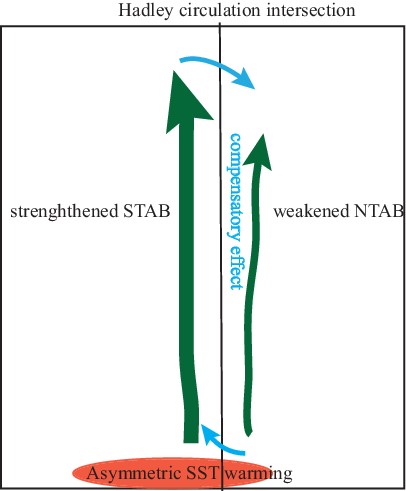Asymmetric variations in Hadley Circulations and the Associated Mechanisms
Date:2018-02-07
In a recent study published in Advances in Atmospheric Physics, scientists from the Institute of Atmospheric Sciences investigate the variations in the tropical ascending branches (TABs) of Hadley circulations (HCs) during past decades, using NCEP, ERA-40 and JRA-55 reanalysis data. They identified and analyzed trends and variability of the northern tropical ascending branch (NTAB; range: 5°–15°N) and the southern tropical ascending branch (STAB; range: 10°S–5°N), which are defined as the ascending branches of the Northern Hemisphere HC and Southern Hemisphere HC, respectively.
The reanalysis datasets consistently show a persistent increase in STAB during past decades, whereas they show less consistency in NTAB regarding its decadal- to multidecadal variability, which generally features a decreasing trend. These asymmetric trends in STAB and NTAB can be attributed to asymmetric trends in the tropical SSTs.
The relationship between STAB/NTAB and tropical SSTs was further examined regarding their interannual and decadal- to multidecadal variability. On the interannual time scale, STAB and NTAB are essentially modulated by the eastern-Pacific type of ENSO, with a strengthened (weakened) STAB (NTAB) under El Ni?o conditions. On the decadal- to multidecadal time scale, the variability of STAB and NTAB is closely related to the southern tropical SSTs and the meridional asymmetry of global tropical SSTs, respectively.
The results indicate that the tropical eastern Pacific SSTs (southern tropical SSTs) dominate the tropical SST–NTAB/STAB relationship on the interannual (decadal- to multidecadal) scale, whereas NTAB is a passive factor in this relationship. Moreover, a cross-hemispheric relationship between NTAB/STAB and the HC upper-level meridional winds is revealed.

Schematic diagram of asymmetric changes in STAB and NTAB due to asymmetric warming of tropical SSTs.
Sun, B., 2018: Asymmetric variations in the tropical ascending branches of Hadley circulations and the associated mechanisms and effects. Adv. Atmos. Sci., 35(3), doi: 10.1007/s00376-017-7089-z. https://link.springer.com/article/10.1007/s00376-017-7089-z
